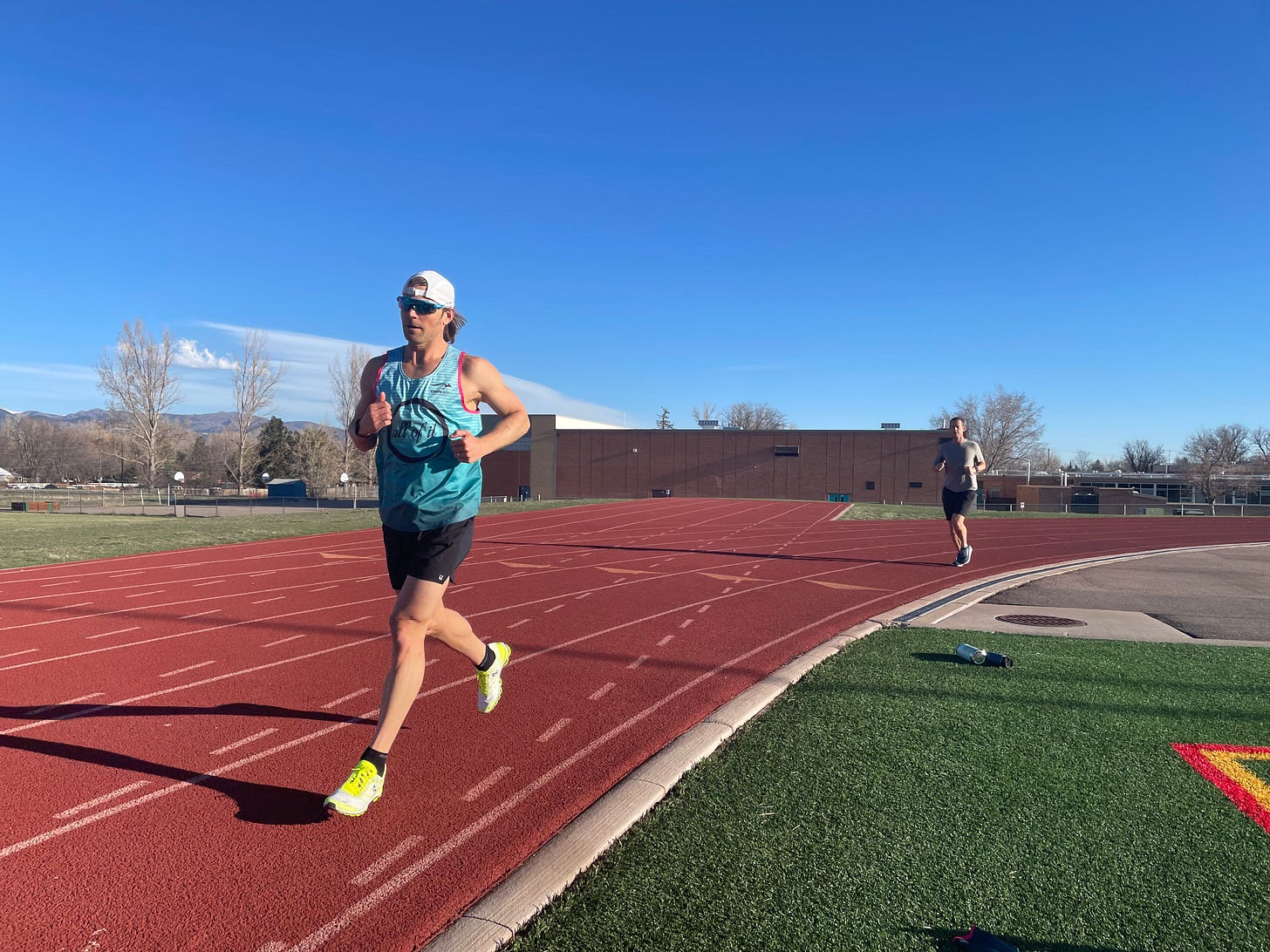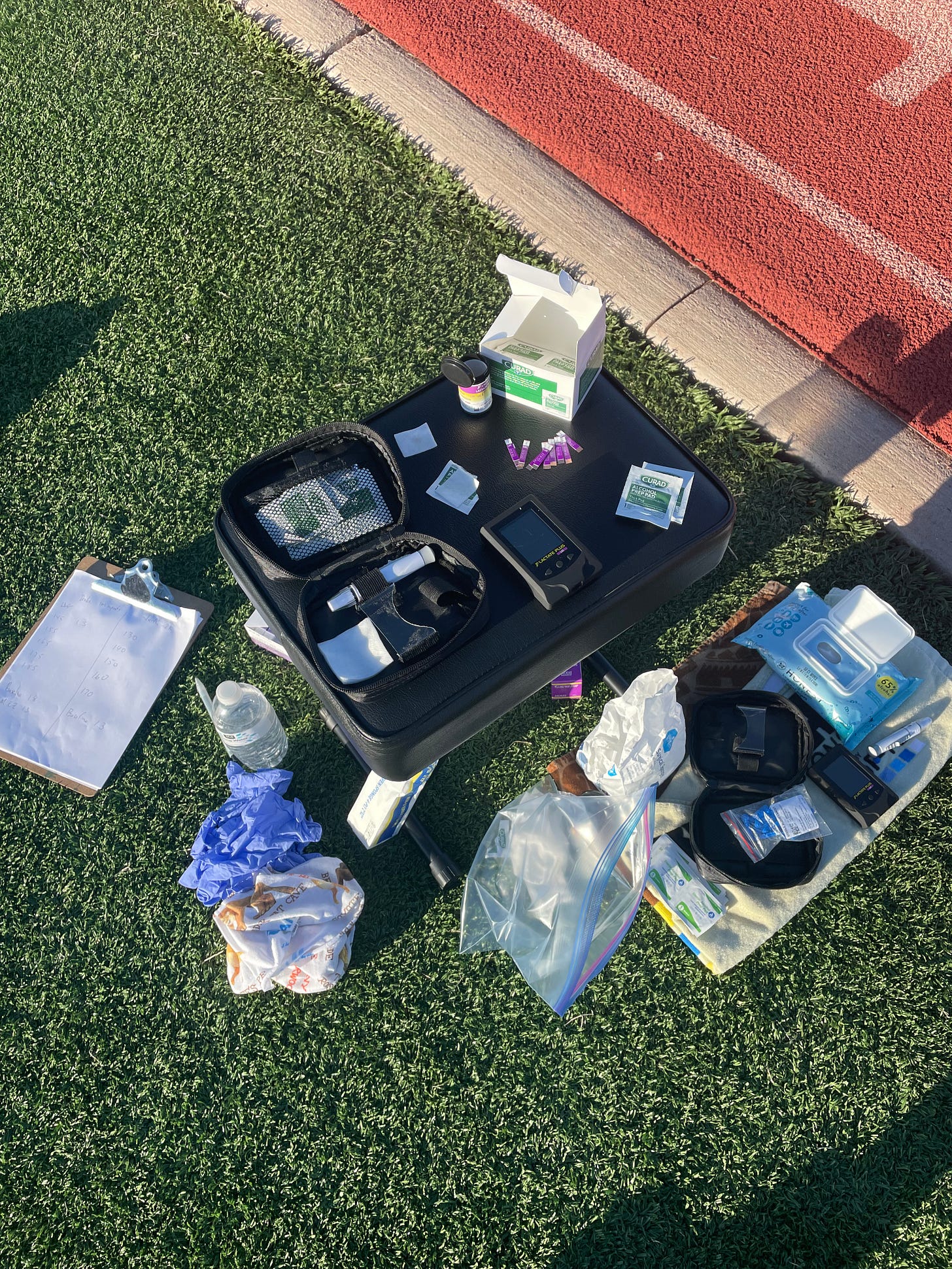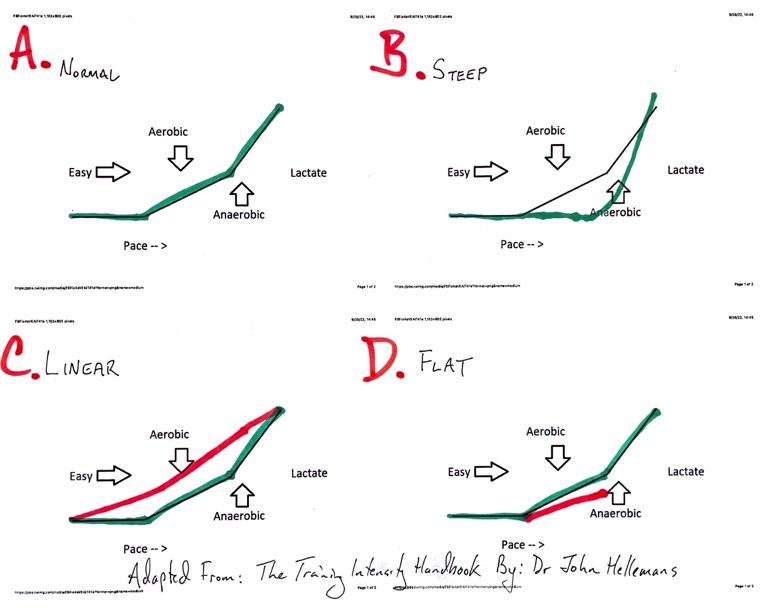Let’s recap what I’ve explained so far:
Article: Building Run Volume Via Frequency
Article: Developing Your Long Run
Section: Using Strides In Your Basic Week
Video: Placing Run Workouts
These five pieces of content are where you will find the biggest gains.
You can apply them for many years, and improve each year.
At some point,
You might be tempted to do some faster running.
You will need to do some sustained training to improve.
Today’s article is designed to help you avoid smashing yourself without a purpose.
I’m going to share my favorite track workout. I’ve done versions of it many times, for many years.
Every athlete can learn from running at the track.
The Progressive Run Test
While endurance is best built bottom up, this test is built top down.
Start with your max heart rate. A legit max heart rate, please. One that you know you can hit, running flat, hydrated, at the end of the test.1
In my case it would be 165 bpm and we’ll use that for an example.
We’re going to target 10 bpm steps during the test, with the last step ending near max heart rate.
Working backwards from my max, the steps are 165/155/145/135/125/115/105/95 bpm.
The steps are going to be 1600 meters, for most.2
Consider the easiest heart rate at which you can run. See what that implies for test distance.
I can run at 95 bpm so that implies 12,800 meters / 8 miles worth of testing. That’s a bit long. What we want is about 10,000 meters of running. So we’d start my test at a target heart rate of 105 bpm.
My targets:
105 bpm
115 bpm
125 bpm
135 bpm
145 bpm
155 bpm
165 bpm (Hit Max At The End)3
The game is to pick an effort for the first 800 meters of each step that will bring you up to target heart rate, but not over. Then hold that heart rate for the second 800 meters.
If this truly is Your First Track Session then your pace may be All Over The Place.
That is OK.
Pace management is an essential skill and the track is an excellent place to learn.
After the test, you’ll be able to compare your first & second splits for each step.
Reminder, take a split halfway on each step.
First half is build-the-heart-rate.
Second half is sit-on-target.
Over time you will learn how to pace evenly…
In A Crowd
Excited
When Rested
That’s what it’s going to take to race well.
Lactate
If you have access to lactate testing then take samples:
Before The Test - this is your Baseline lactate
At The End Of Each Step
Don’t start the test until Baseline lactate is at, or below, 1.5 mmol.
Ideas to get lactate down before the test begins:
An easy ride to the track, with cadence over 90 rpm
10 minutes of Power Walking
1600 meters alternating 100m Powerwalk with 100m Slow Jog
To plot your data, you will find step-by-step instructions in this Twitter Thread.4
Breath Markers
Above, I have seven steps in my test outline.
My steps link, approximately, to:
Recovery / Zone 0
Easy / Zone 1
Steady / Zone 2
Moderately-Hard / Zone 3
Hard / Threshold / Zone 4
Very Hard / VO2 / Zone 5
Build To Max
Each of these efforts is associated with a breathing pattern and feeling.
By starting very easily, you will have the opportunity to feel your entire aerobic range. You will also capture pace data for your entire range.
Specifically, notice when you start panting. That’s a High Zone 4 effort, for most.
Smart endurance training is done well below the effort that causes you to pant.
Case Study
My Twitter buddy, Drake, was kind enough to give the protocol a shot.
With Drake, I asked a simple question:
What’s your threshold effort? An effort, and heart rate, that you can hold for about an hour.
175 bpm, Drake replied.
I then asked:
What’s the easiest heart rate you can run at?
About 140 bpm, Drake replied.
So we decided to build Drake’s steps as
135 bpm
145 bpm
155 bpm
165 bpm
175 bpm
Hit 185 bpm
When we took Drake’s Baseline lactate it was 1.8 mmol.
Wanting Baseline at, or under, 1.5 mmol… I asked Drake to run 1600m as easy as possible.
After four very easy laps, Baseline was down at 1.3 mmol.
The test started, right after sampling lactate, at the 145 bpm step.
The test went great.
A strong “pant” was noted at the end of the 175 bpm step. Right where Drake expected his Threshold Effort to be.
At 185 bpm, Drake felt there was no way he’d make another step. He maxed his progressive effort.
So the test ended.
Lessons
Drake’s data gives us insights into common situations athletes face. His profile is similar my own when I started running.
Nominal Lactate Levels Are Personal - Drake was at, or over, Zone 4 effort at the 175 bpm step. However, his lactate reading was 2.2 mmol, which could be a comfortable effort for a different athlete.
If Drake was reading the web and targeting 2 mmol for “sweet spot” training then he’d be aiming his endurance work WAY too high.
If Drake was caping endurance training at 1 mmol above Baseline then he would have the same problem. His target would be far too high for endurance work.
Breath Markers Are Key - in the upper zones, athlete feeling & breathing provide essential information. Drake’s breathing told us more about his effort than the nominal lactate value.
Shape of the Lactate Curve - Drake’s current curve is linear.
His warm-up pace was faster than his 145 bpm pace. His pace faded in the first 20 minutes. This is common.
After 30 minutes of running, all of which felt easy, Drake’s lactate started to rise. This is also common. Easy feeling does not imply easy inside the body.
A linear lactate curve is the most common profile and good news for Drake. He is going to see material gains from a focus on Easy & Steady running.
Linear Curve Athletes:
Decouple5 Quickly in Zones 3 & 4
Should Focus on Base, Strength & Quickness6
Should Limit: Zone 3, and higher, efforts
Should Limit: Hills, due to rapid heart rate spiking
I gave Drake two tips:
Keep Your Easy / Zone 1 Under 150 bpm
Keep Your Steady / Zone 2 Under 160 bpm
At the end of the session, Drake asked the Million-Dollar Question…
How will I know I am improving?
Benchmarking Over Time
I recommend two types of benchmark sets:
Submax Progressive Sets
Steady-State Efforts With A Heart Rate Cap
Submax Progressive Sets
Repeat the submax part of the test.
In Drake’s case:
135 bpm
145 bpm
155 bpm
165 bpm (20 bpm below max)
Choose either 1600 or 2000 meters for each step, with halfway splits taken.
For a triathlete, this makes a nice transition run, after a bike ride.
For a runner, jog easy to the track, do the set, jog home.
Steady-State Efforts With Heart Rate Cap
To check for submax pace fade, use longer segments with a heart rate cap.
Perform a gradual warm-up on a flat route
Run a 5 to 10 km segment7
Gradually build heart rate to a submax target
Stay on the heart rate target
Take splits and accept whatever pace results
In Drake’s case, he could benchmark pace at 150 bpm (Easy Cap) or 160 bpm (Steady Cap).
There’s nothing magical in the heart rate selected for benchmarking. Just make sure it implies an Easy, or Steady, effort. Choose a course, and protocol, that can be repeated year round.
My recommendations:
Check paces at both
Mostly benchmark around first lactate threshold / Steady effort.
Do not worry about day-to-day pace movements.
Understand that temperature changes will impact pace vs heart rate data.
Gather data over time.
These “tests” are not demanding. They are normal endurance training and let the athlete build a data set.
There will be noise in the data.
The tested paces will move around.
The trend should be clear.
If you are consistent then submax paces will improve.
Submax Variation For Advanced Runners
Advanced runners with normal, or steep, lactate curves should use this submax test:
1600 meters relaxed & easy
4800 meters with heart rate capped at 30 beats below max10
3000 meters with heart rate capped at 20 beats below max
The 4800 is intended to be a Steady benchmark and the 3000 should be aimed at a Moderately-Hard intensity, Zone 3 in a Five-Zone System.
Final Word
Let’s end with tips for all runners.
If you are stamina, or arousal control, limited then your paces are going to fade, very obviously. Accept the fade and keep your HR under the target ceiling.
Seeing fade is valuable. Continue to work on stamina, you do not need to increase training paces, and you might need to slow down. Focus on frequency.
Even as a speedy elite, I would see significant pace fade after taking a break, when tired post race and early season.
For elites, submax benchmarking is an effective warm-up before a CrissCross Threshold, or VO2, session. Easy running after your main set can bring session length to 15-21 km.
I love these variations. Submax benchmarking gave me reliable information that translated to race performance. For many years, I benchmarked at 140/150 bpm. My max heart rate at the time was ~170 bpm.
More On How To Use The Progressive Run Test
Back To Table of Contents
Please, please, please… before training… get clearance from a licensed medical doctor. One of my elite peers left a young family widowed and fatherless when his heart stopped during a track session.
I’ll be sharing an advanced runner’s case study in a future article. If your 10K time is 38-minutes or faster then consider using 2000 meter steps and tracking 1K split times.
Max testing is costly in mojo and recovery. Use it wisely, and sparingly.
Article to come.
Here’s my video on Decoupling & Duration Curves.
Advanced runners can place the flat benchmark after 30-60 minutes of running in the hills. Triathletes can gain useful information by benchmarking off the bike.
Here is a video on Finding Aerobic Threshold, also known as first lactate threshold (LT1). My article The Importance of Submax Benchmarking explains how to find LT1 and calculate your normal heart rate range at that intensity.
When I was starting out this was called Max Aerobic or MAF heart rate. Here’s an article about the history of the “180 minus your age” formula associated with MAF. I do not recommend age-based formulas for serious athletes.
This point should be near first lactate threshold (LT1). Adjust targets if 30 beats below max is not near a Steady Endurance Effort. The upper heart rate target is intended to be 10 bpm above a Steady Endurance Effort.








This one: Epic Lite @ Alpe d’Huez Triathlon 2024?
I will race some local stuff this year and maybe nathional 70.3. Next year we are considering Boulder. www.fasterinpink.com
I Gordo. In the last part of this article you cited "I’ll be sharing an advanced runner’s case study in a future article". Where can I find this case study? Moreover, It's not clear to me the differenze between the progressive test and the full-profile test (using lactate monitoring in both case) and the differences/advantages/disadvantages in adopting time (5 minut) or distance (1600 mt) for the steps lenght. Many thanks.